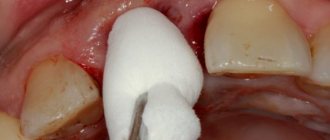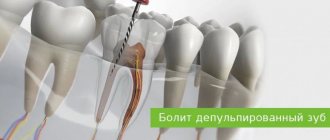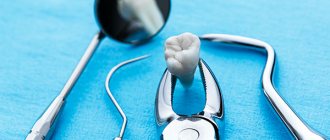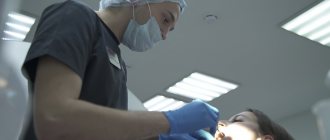The one-stage technique mainly includes one-stage implantation protocols with immediate loading, but in some situations, simultaneously with tooth extraction, a classic implant can also be installed using a two-stage technology. According to many clinical studies, it is one-stage implants installed in the socket of an extracted tooth that protect bone tissue from atrophy and can reduce treatment time with a guaranteed high long-term result of up to 96%1.
Indications
- teeth to be removed are rotten, mobile, destroyed by carious processes,
- single restorations,
- multiple restorations,
- tooth injury,
- simultaneous tooth extraction and implant installation.
Contraindications
- emergency tooth extraction when it is not possible to prepare for implantation,
- complex tooth extraction,
- general contraindications to implantation and surgery.
Dental drainage: what it is, what it looks like
What is tooth drainage? Translated from English, “drain” means “to drain.” This is a medical instrument or device, the main purpose of which is the continuous removal of liquid contents from inflamed tissues and cavities. Usually it is inserted into open wounds and left for a short time, thus, with its help, a procedure is carried out that promotes the outflow of pus, serous exudate, blood and ichor.
This device was first invented by a French surgeon. It was originally created from materials such as glass and rubber. Today, lighter, softer and smoother materials are used for manufacturing: rubber, silicone and latex - they do not get wet, are well fixed and hold, and do not cause significant discomfort.
If you want to know what dental drainage looks like, look at the photo below. This device looks like a small thin tube, and in some cases it even looks like a thin wire, tape or just a strip of material. The device has different sizes and diameters.
Overall: what can be put in place of an extracted tooth and which method should I choose?
If budget and time allow, it is best to opt for dental implantation and subsequent implant-supported prosthetics.
A solution for a more modest wallet would be to install a dental bridge.
And finally, if one or a pair of teeth are missing, a removable denture is recommended only as a temporary solution!
Material checked:
Implantologist, surgeon, periodontist - Rozhnov Sergey Mikhailovich
Indications for installing the system in the gums
Let’s take a closer look at who gets drainage and why. Many patients consult a doctor with an acute inflammatory process and severe swelling of the tissues of the oral cavity (and sometimes even the face), caused by advanced diseases and accompanied by the appearance of a lump or abscess on the gum.
In this case, it is simply necessary to resort to surgical measures, namely, to cut the inflamed gum, as well as the abscess, and release its contents. To prevent the wound from quickly overgrown again, and to prevent pathogenic contents from remaining and accumulating inside it again, specialists place a drainage on the tooth.
So, the main indication for installing the device: a purulent-inflammatory process in the mouth caused by pathologies such as advanced pulpitis and periodontitis, gumboil, fistula, abscess, cyst and granuloma. A wide opening of the purulent cavity and drainage of pathological foci are also carried out in such serious diseases as odontogenic osteomyelitis and phlegmon [1], when the bone structures of the jaw and soft tissues of the face are affected.
On a note! The procedure is contraindicated in patients with bleeding disorders and allergies to painkillers used during the operation and the incision on the gum.
Presence of contraindications
The main obstacle to dental bridge prosthetics mentioned above is the end defect. Another contraindication may be severe malocclusion.
Obstacles to implant installation:
- Significant deficiency of bone tissue (preliminary augmentation is required).
- Diseases of the cardiovascular and central nervous systems.
- Decompensated diabetes mellitus.
- Pathologies and dysfunction of the thyroid gland.
- Tuberculosis.
- Disruption of the chewing muscles.
Drainage of the hole after the root removal procedure
Separately, it is worth mentioning situations when drainage is installed and the socket of an extracted tooth is drained. The procedure is indicated in the following cases:
- immediately after removal of a neglected and irreparable unit that has caused the appearance of an abscess in the oral cavity: if the manipulation is not performed, the likelihood of developing postoperative complications increases,
- drainage in the gums after tooth extraction is a mandatory treatment measure for those patients who have developed purulent complications during the rehabilitation period: alveolitis, gumboil, abscess,
- drainage is often installed after the removal of a wisdom tooth, and this is done to directly administer medications into the wound, which ensures rapid tissue healing and, of course, minimizes complications.
How to place a tooth if there is no root? Build a bridge!
If a tooth is missing, then you can choose bridge prosthetics. The prosthesis itself consists of several “glued” crowns, the number of which depends on the number of teeth that need to be restored. If one is missing, then the bridge will be three units. If we are talking about a double gap in the dentition, then a bridge of four units is used.
The process of installing a bridge on teeth
- dental impressions are taken
- the prosthesis itself is made
- installation process: grinding down adjacent teeth and fixing the prosthesis with dental cement.
The advantages of this solution are the relatively low price and low invasiveness of the procedure (compared to dental implantation). The disadvantages are the need to sharpen healthy teeth, the need for special hygiene, and the lack of load on the bone in the place of the missing tooth (as a result, the gum tissue under the “hanging” tooth will decrease over time).
Bridge prosthetics can be carried out both in case of a lack of chewing teeth and in the frontal zone.
You can read more about the method, technology and nuances in this article
Features of the procedure
Let's take a closer look at how drainage is placed on a tooth. The procedure includes several important steps.
Stage No. 1
First, the specialist conducts a thorough visual and x-ray examination of the inflamed area to get an accurate idea of the location of the abscess, its size and depth.
Stage No. 2
The doctor administers local anesthesia so that the patient does not experience pain during the procedure. Next, at this stage, surgical intervention is performed.
If the tooth next to which the abscess has appeared can still serve, then the specialist cuts the inflamed gum with a scalpel. In cases where saving the tooth is not practical, the dentist removes its root, after which he places a tube to drain the fluid directly into the open socket (in this case, no tissue incision is made).
Stage No. 3
The opened purulent cavity is thoroughly cleaned, treated with antiseptic solutions, after which drainage is fixed in it. One end of the device is inside the wound, and the other is outside.
Next, the doctor prescribes medications, antiseptic rinses and antibiotics for home use, which, together with the installed device, will work to quickly eliminate the inflammatory process and normalize the patient’s condition.
When is it necessary to remove a tooth along with the root?
All decent dentists try to preserve “their” patient’s tooth in every possible way. Even if we are talking only about the remaining root, today there are also several restoration options. One of the most popular is prosthetics using a stump tab.
However, in some cases complete extraction of the tooth is indicated, i.e. removal of both the coronal part and the root.
Indications for root removal:
- granulomas or cysts that do not respond to drug treatment;
- destruction or severe deformation of the root;
- inability to treat root canals (usually also due to deformation or non-standard shape);
- maxillary osteomyelitis;
- periodontitis or periodontal disease in a late advanced stage. In this case, the roots of the teeth have increased mobility and also act as a kind of “foundation” for tartar;
- cracks in the root or perforated bottom (such phenomena are contraindications for prosthetics using a stump inlay);
- “forgotten” fragments of dental instruments that cannot be removed;
Feelings after installation
Experts say that if the device is installed correctly, it should not cause any discomfort. Yes, its presence in the mouth can be felt by directly touching it with your finger or tongue. But the drainage in the tooth should not cause pronounced discomfort, rub the mucous membrane and get in the way. It is normal and correct if liquid is constantly released through it.
If you have a tooth removed and drainage installed, the sensations will, of course, be more pronounced. After all, you have undergone a full-fledged surgical operation, after which swelling, pain, a slight increase in body temperature, and difficulty opening your mouth are possible. However, all these symptoms are, to a large extent, just normal consequences of extraction (removal). But in some cases they can indicate serious complications. How to separate normality from pathology? The answer to this question is in the feature article on the site.
Why can’t you “walk without a tooth”?
The absence of even one tooth entails a number of unpleasant consequences for the health of the oral cavity and the body as a whole. The insidious thing is that these consequences occur very systematically and unnoticed by the patient.
- The chewing load on neighboring teeth increases and, as a result, their lifespan is reduced
- Neighboring teeth, without the support that was present before, begin to move and try to close the resulting gap. As a result, the teeth become crooked and the correct bite is disrupted.
- Aesthetic discomfort (especially important for front teeth)
- Gastrointestinal problems due to poorer chewing of food.
Duration of treatment
Many patients are interested in how long tooth drainage costs. On average, it is left for 3-6 days. During this time, all pathogenic fluid should completely leave the wound. If all is well, the patient usually feels relief within 24 hours after installation. With each subsequent day, positive dynamics are observed, swelling subsides and disappears, and the color of the mucous membrane normalizes.
It also happens that after this period, unpleasant symptoms of the disease persist, which means that the inflammatory process continues. Then doctors conduct a new examination, adjust treatment tactics and resort to other measures.
If there is drainage after tooth extraction, when can it be pulled out? The doctor decides. If the dynamics are positive, the tube is removed after 3-4 days. When the inflammatory process persists or complications of extraction appear (for example, alveolitis), the specialist pulls out the tube, performs a thorough curettage, that is, cleaning the hole, after which he can reinsert the device.
How to make a tooth if there is no root? The third solution is dental implantation
Dental implantation is considered the most reliable way to “insert teeth”. The implant (pin) acts as an artificial root onto which the crown is fixed.
Modern dental implants have a high survival rate (from different manufacturers the figures fluctuate around 98-99%) and a long service life.
Dentures (crowns or bridges) will last 15-20 years, and a high-quality dental implant installed by good specialists will last a lifetime.
The advantages of this solution:
- complete restoration of the tooth, both from a functional and aesthetic point of view;
- the implant will provide load on the bone - the gums will not “decrease”;
- implantation can be carried out both in the case of a single missing tooth and in cases of complete edentia;
- there are solutions for restoring a full dentition (All-on-4, All-on-6, Trefoil from Nobel Biocare);
- in case of indications for single-stage implantation, the crown is placed on the day of installation of the artificial root;
Flaws
Every place has its own nuances, and if there is no root, the tooth is “needed” and you decide to install an implant, you need to know about the disadvantages:
- the operation is expensive and it is necessary to budget for not only the cost of the implant, but also the cost of the crown;
- if a one-stage operation protocol is not available, then after installing the implant, before installing the crown, you must wait three months until the process of osseointegration (fusion of the root with the patient’s bone) is completed;
- The postoperative period may cause discomfort for 3 or even 5 days.
Rules to follow when having a device in your mouth
Anyone who has had drainage installed after a gum incision or tooth extraction needs to know how to behave during this period. Doctors give the following recommendations:
- you need to follow a certain diet: it is forbidden to eat hot and hard foods and chew on the side of the jaw where the intervention was performed. You need to give preference to soft and liquid dishes, drink more clean water,
- It is undesirable to sleep on the cheek on which the device is installed,
- Brushing your teeth should be done extremely carefully, avoiding the area where the tube is located: for hygiene, you can use a brush with soft bristles and a non-abrasive toothpaste. It is better to avoid using an irrigator for a while,
- Intensive rinsing of the mouth is prohibited: to carry out antiseptic and disinfectant procedures, simply take liquid into your mouth, hold for 2-3 minutes, spit it out,
- It is important to protect yourself from physical activity and sports.
How much does it cost to get teeth inserted?
Teeth can be inserted in different ways and using different crowns or dentures, so the price of the service can be very different. Below we publish prices for services for restoring damaged or lost teeth, which are offered by our dental clinic in Moscow - “Aesthetica”!
If you want to insert teeth so that the restoration result is both beautiful and high-quality, come to our dentistry! We have created all the conditions for high-quality, painless dental restoration in the most difficult cases!
What to do if the device falls out
Some patients do not even have time to find out how the tooth drainage is removed at the dentist, because the tube itself falls out of their mouth. What to do in this situation? If the system falls out in the first few days after the procedure, then you need to quickly contact your doctor to have it reinstalled. During this period, the likelihood that all the pus has come out is still too small, and the wound will heal very quickly, accordingly, pathogens will remain inside it.
If the device falls out 4-5 days after the procedure, and you notice that the swelling has subsided and pus is no longer oozing from the wound, then there is nothing to worry about. In this case, we can assume that the drainage installed for the treatment of various dental pathologies and after tooth extraction has successfully fulfilled its purpose. However, you still need to see a doctor.
Important! The main reasons for premature loss of the device: improper oral hygiene technique, active rinsing, violation of the postoperative regimen, poor-quality installation of the tube in the dental office.
Expert opinion
Elena Vladimirovna Orlova
Specializations: Dentist-therapist, endodontist
Experience: 33+
“Under no circumstances should you install drainage on a tooth yourself. You can injure the tissues or, even worse, introduce an infection into them, after which the inflammation will flare up with renewed vigor. All procedures for its installation and removal must be carried out by professional doctors under completely sterile conditions."
If, nevertheless, the patient postponed the start of implantation
And he put it off for a very long time. Returns to the doctor after a few years, for example. What regulations will be followed in this case for implant installation? Here, the moment of implantation also depends on the previous tooth extraction. The dentist must remove the tooth in such a way as not to damage the walls
bone tissue. That is, atraumatic:
You should always try to remove the tooth as carefully as possible. And if the tooth was removed with damage to the bone tissue, and the patient was not implanted immediately, then after two months the question of bone tissue augmentation will arise. What to say if the patient arrived even later? Of course, the question of bone restoration and bone grafting will arise.
How disadvantageous is it for a patient to delay dental implantation?
Research conducted in Russia by independent institutes shows that there is no increase in the number of implantations from year to year, despite the fact that the total number of dental services provided to the population is growing steadily every year. The most popular type of implantation is the implantation of the frontal group of teeth, that is, the front teeth. But in the area of the chewing group of teeth, patients are in no hurry to undergo implantation.
Are there medical reasons for postponing dental implants? Medical reasons for refusing to install a dental implant include general reasons:
(diabetes mellitus, hormonal changes, systemic lupus erythematosus, HIV infection, etc.) and
local
.
For local reasons related to the area of the mouth, at present there is practically no list that existed in Russia 15-20-25 years ago, when this area of dentistry had just begun to develop in the country. At that time, the widespread leadership was held by removable dentures, which had and still have a number of serious disadvantages. Yes, there were many local medical reasons, but progress and technology do not stand still. Therefore, now we can (even conditionally) talk about the general reasons for delayed dental implantation, which I mentioned above.
Removable prosthetics as a deterrent to implantation
Removable prosthetics, which prevents the increase in the number of requests for implantation, should probably be considered from the point of view of the economics of patient costs. Removable dentures are much cheaper than implantation followed by turnkey prosthetics. But removable dentures have a significant drawback - they do not prevent the resorption of bone tissue, and in some cases they increase the rate of resorption, with an increase in the pathological load on the temporomandibular joint (TMJ).
Therefore, in the long term, dental implants have a huge advantage
before removable prosthetics to preserve the patient’s bone tissue and, accordingly, the healthy state of all the patient’s maxillofacial system. As they say, “the miser pays,” but not twice, but several times more during his life with removable dentures.
Self-removal of the structure: possible or not
Some patients experience severe discomfort, so they are interested in how to remove drainage from a tooth on their own. Others do not have time to make an appointment with a doctor on time, so they also want to know the answer to this question. Often, the dentists themselves provide detailed instructions so that the patient can perform the procedure at home. The procedure should be as follows:
- wash thoroughly with soap and disinfect your hands,
- treat the oral cavity with some antiseptic: Miramistin, Chlorhexidine are suitable,
- stand in front of the mirror, open your mouth, carefully grab the tip of the tube protruding from the wound with your thumb and forefinger and pull it towards you without force,
- rinse your mouth with an antiseptic,
- Do not consume food or drink for the next 2 hours.
“On the eve of the New Year holidays, I had a drainage installed after the removal of a dental cyst. The procedure is painless, as it is under anesthesia, but the doctor said that due to the holidays, I will have to pull the tube out of the wound myself in four days. I described in detail how this is done. When the hour struck, I was very worried, I thought it was difficult, but in fact I did everything quickly. However, after ten minutes the pain was so severe that I had to take pills. But within a day I even forgot that I once had this tube. After the holidays, I saw the doctor, he said that I was good, and the tissues were healing normally!”
Irina R, review from 32top.ru
The procedure is simple, but if the device has not fulfilled its main purpose, then it should not be carried out under any circumstances. And, in general, even if your condition has improved significantly, you should not resort to independent measures without consultation with a specialist. It is better to have a professional doctor perform all steps to remove the device. Why? Removing the tube yourself can cause severe pain, prolonged bleeding, damage blood vessels and injure surrounding tissue.
Removable prosthetics
If there is no tooth, what can be supplied from budget options? This is where removable prosthetics comes to the rescue. It is also relevant if there are contraindications to prosthetics using crowns and implantation.
Butterfly prosthesis
Such a denture is relevant in the absence of one or maximum two teeth in a row. It consists of an artificial gum and crowns sewn into it. The design also has hooks to secure the removable denture on healthy teeth.
It is not possible to say that the “butterfly” can fully fill the gap in chewing function, so doctors recommend using the design only as a temporary measure.
Clasp dentures
If more than 1 or 2 teeth are “missing”, then the recommendations of orthopedists are clasp dentures. They can be attached to healthy teeth using clasp hooks, telescopic crowns or attachments.
You can also choose acrylic or nylon dentures as a solution. The latter are the most comfortable to wear, but are subject to stretching. Also, the nylon version cannot be “fixed” - after some time you will simply have to order a new one. Popular models – Acry-free and Quattro Ti











